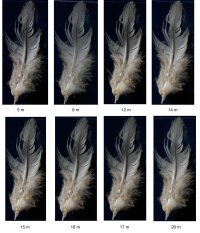privatebydesign said:AlanF said:jmatzen said:Helevitia said:I am also worried about missing out on the advantage of having a cropped sensor.
I signed up an account just to comment on this. There is *no* advantage to a crop sensor. How would you feel if you had FF camera, but the camera cropped the picture before it saved it to the card? You would feel cheated! Same deal, only it's a physical limitation.
Source: I am a senior optical engineer.
Yes there is an advantage: the resolution of a sensor depends on the size of a pixel, the smallest image that can be resolved into two separated points is one where the distance is circa 2 pixels. The pixel on the 6D is 6.54 micron, that on the 7D is 4.3 micron. So, with the same lens on each body and iso noise not being limiting, the 7D can resolve a separation of 8.6 microns as opposed to the 13.08 microns on the 6D. So, the 7D has 48.8% more reach than the 6D, which is a huge advantage for bird photography and is why the 7D is so popular for nature photographers. I am waiting for the 7D II.
The resolution of a camera system and the subsiquent images depends on a hell of a lot more than pixel density. Stop reading badly written forum posts and test this stuff, it really is very easy.
I posted this a while ago but it is very relevant here, and I didn't explain the test situation very well last time. The attached photo contains three images, the one on the left is from a FF camera, the smaller red rectangle inside that is the full 7D image. Both images were shot from the same place with the same lens using manual focus and 10x Live View, a cable release, remote flash, IS off, very heavy tripod, with a 300mm f2.8 IS @f5.6. This is a typical focal length limited situation and I set this up to see the actual resolution advantage I would get were I to get a 7D, in doing so I have absolutely maximised the advantage of the crop camera, we never shoot in these kinds of ideal conditions other than a studio still life.
In real life testing, when using AF and its associated inaccuracies, even the small resolution advantage the 7D has in these examples isn't realisable.
So, where is that 7D 48.8% reach advantage?
OK, so I've looked at your pictures and read some more online about FF vs. crop sensors. Wouldn't it be better to say we are losing picture real estate instead of magnifying the image 1.6x? If we are, in fact, not actually getting closer to the subject, then why does everyone say it like that? Why not say the opposite?
And one other question about this: If I take a picture with a crop sensor at let's say, 12 ft, I then take the exact same picture with a FF sensor, at around 8ft, I'm going to get the exact same image size. Now let's assume for a second I cannot move closer to the subject to "equal" the crop sensor size. Do I miss out on anything?
Also, what about the resolution within the crop sensor? If both the crop and FF sensor have the same megapixel, does that mean I have more detail in the picture on the crop sensor vs. the FF sensor or is it really just that it's exactly that, it's cropped out the extra real estate so it's the exact same? Whew! Hope I made sense?
Upvote
0

